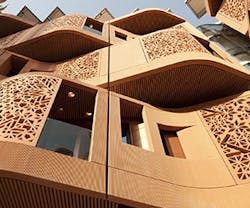Dubai: Energy Disaster or Destination?
In late January, I visited Dubai in the United Arab Emirates (UAE) on business. It is a multicultural mixing pot of people and buildings, and it includes some of the most expensive and innovative building projects on the planet. Dubai has malls with indoor snow skiing resorts, massive man-made island chains that stretch for miles into the Persian Gulf, and the tallest building in the world (more than twice the size of the Empire State Building). The latitude is 25 degrees North (about the same as Miami) and thus solar heat gain is the primary enemy of building designers. Summer temperatures regularly hit 110 degrees F. for several months.
Unfortunately, there has been a large disconnect between building developers and occupants (often buildings are constructed by one party and then sold to another). Thus, although most of Dubai and Abu Dhabi, the capital of UAE, have relatively new modern infrastructures (and quite aesthetically pleasing), the glass-clad buildings are not the most efficient (many engineers describe them as “greenhouses”). Dubai is one of the highest per capita energy and water consuming cities, and 95% of its drinking water comes from desalination plants driven by waste heat from electrical generating plants powered by natural gas. With the searing heat, smog, dust and sand, Dubai has its challenges. It is looking for ways to become more sustainable as its oil and gas reserves are on the decline (accounting for only 7% of its GDP at this time). Dubai is developing more sustainable buildings and more tourism. I think the strategy is “if you build it, they will come.” And they have. Only about 20% of Dubai is populated by native Emiratis, with Indian nationals representing the largest share of the nonnative population.
I was able to take a side trip to a new “eco-city” called Masdar, which is under construction near Abu-Dhabi. In January the temperatures were in the 70s during the day and 60s at night, so quite pleasant compared to their summer. The Masdar concept is a pedestrian-based, integrated mixed-use development that is 100% powered by solar energy. Although most of Masdar is under construction (and will be expanding for some time), a small city center is operational. So far about 10 buildings have been constructed in this center, where people can live and walk to work through shaded passageways that are passively cooled and relatively comfortable. There are many design innovations, including innovative use of solar tube skylights, which are cleverly disguised as decorative floor tiles for the courtyard floor above. Masdar’s operational results are about a 50% reduction in energy and water consumption from “business as usual” regional benchmarks. From a construction standpoint, Masdar also reused/recycled about 96% of its construction waste, and re-purposes 100% of its waste water for landscaping, which is quite impressive.PageBreak
To visit Masdar, you park under the city in a massive concrete structure that serves as part of the passive cooling strategy. From there you walk to a ministation of “pods,” 4-seat automatically guided vehicles (AGVs) that wisk you a few hundred yards away to the campus’s institute, where many of the architects/builders and clean-tech researchers are currently living. The electrically driven AGV parks itself in a special spot and recharges via magnetic induction without connections. Most of the four-story rooftops are covered by solar panels, which provide 30% of the electrical power, with the remainder coming from a 10MW solar field adjacent to the city structures.
There were a lot of demand-side building strategies in play, such as occupancy-based air curtains on the outside doors, which only turn on when a door is opened. The air curtains help keep the cool air in the building and the occupancy sensor saves a lot of energy. There were also dimmable lighting, VAV, multi-stage absorption chillers, and other systems that are avoiding waste.
I also saw multifamily residential buildings with three times the wall insulation as conventional buildings. Portholes provide indirect sunlight, illuminating areas deep inside the buildings. Most of the commercial buildings have aluminum skins on the south and west sides to screen them from solar heat gain. Numerous light shelves and automated shades kept the interior light optimized without glare. In all, it was quite a comfortable place to walk around and one that people will want to visit. More information is available at the Masdar City website: http://masdarcity.ae/en/.
In closing, the only missed energy opportunity I saw was in the Caribou Coffee Shop, which had incandescent lights. Still, Masdar is an educational experience that offers a more sustainable blueprint for arid climates.
